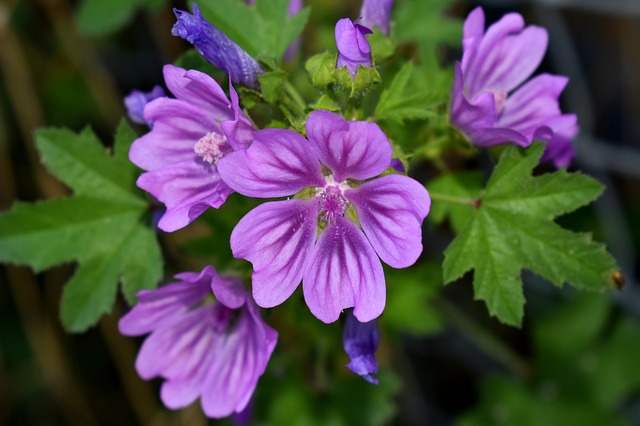 |  |  |   |  |
 |  |  |  |
Annual or biennial plant, 20-100 cm tall, with a well-branched central taproot. Stem erect, hairy, little branched. Leaves without leaflets, ordinary, rounded kidney-shaped, 5-7-parted or almost whole, softly hairy, on long petioles, which are also covered with hair, only very rough. The pages are arranged alternately.
Flowers bisexual, large, bright pinkish-purple, 3-4 cm in diameter, actinomorphic on long peduncles, solitary or in cymes.
The fruit is dry and splits into several parts (mericarps) when ripe. Seeds with endosperm. Characteristic glottis cells in the flower. Blooms from June to September. A heat-loving plant.
In folk medicine, the roots, leaves, flowers and stems are used in their entirety. The above-ground part of the plant is harvested until the plant has started to bloom. Leaves are cut with stems 2 cm long. The leaves can be collected from June to September. Flowers - during the boutonization period until they bloom. Roots are dug in autumn. To preserve the active substances, the plant is dried at low temperatures or on sieves in a well-ventilated and shaded place. Flowers, leaves and roots are stored for up to 2 years.
The medicinal properties of
common Mallow
are determined by its chemical composition. The plant contains terpenoid compounds (monoterpenoids, norsesquiterpenoids, diterpenoids); phenols and their derivatives (4-hydroxybenzyl alcohol, tyrosol); phenolic acids (including ferulic acid), coumarin (scopoletin). It has even been found: in leaves - flavonoids, in flowers - anthocyanins (pigments), in stems and leaves - fatty acids, as well as vegetable fats (<18%). The plant also contains ascorbic acid (<3% in leaves, <1% in flowers) and vitamin A (in leaves <0.05%), sugar, mucilage and tannins.
Medicinal significance
Common Mallow
has many medicinal properties: covering, anti-inflammatory, expectorant, softening, soothing, analgesic, immunostimulating properties. It has been determined in the experiment that the
common Mallow
water extract acts as an immune system stimulant and antioxidant. The extract has antibacterial activity. Common Mallow
preparations also have digestive tract regulating properties.
Common Mallow
is a plant that has long been known in natural healing. Flowers, leaves, stems and roots are commonly used in folk medicine. In addition, folk scientists recommend using plant extracts and decoctions both internally and externally.
Preparations from the flowers and leaves of the
common Mallow
are used to treat spastic colitis, constipation, as well as as a sedative in case of long-term cough, colds, flu, bronchitis, stomatitis and periodontitis. Common Mallow
is an effective remedy for the prevention of diseases of the digestive tract and urinary tract. With its help, inflammations in the digestive tract, kidneys and urinary tract are relieved. Decoctions and decoctions are taken orally, as well as gargles and inhalations to relieve coughs, colds, hoarseness and catarrh of the throat.
The root and surface part are used to treat conjunctivitis and blepharitis, leaves and flowers as compresses for tumors. In the practice of folk medicine, fresh
common Mallow
leaves are used to fight avitaminosis.
Common Mallow
is included in medicinal plant mixtures with yarrow, oats, medicinal chamomile, baths, ointments and compresses. Compresses of flowers and leaves are used to soften the breasts during breastfeeding.
Common Mallow
is also widely used in home cosmetology and dermatology. The decoction is used externally in applications to soften and remove itching in case of skin diseases. Compresses from
common Mallow
are used to heal purulent wounds, burns, consequences caused by herpes viruses, in case of dyshidrosis, as an anti-inflammatory agent. Common Mallow
root is recommended for rinsing hair after shampooing. Flowers and leaves are included in cosmetic mixtures used for facial masks - for dry and sensitive skin, age wrinkles and to refresh the facial skin.
For men
The plant is used to treat impotence.
